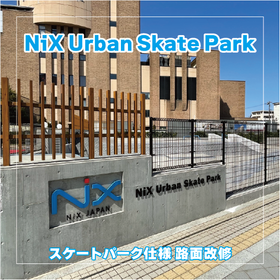This is a revetment method using high corrosion-resistant alloy coated steel plates and thinned timber logs.
Tōō Kingiken Co., Ltd. has developed the "Ee Frame," a revetment method that excels in economy, construction, and functionality, utilizing high corrosion-resistant alloy-coated steel plates (Nippon Steel's Super Dima) and thinned timber logs as alternatives to traditional river construction methods such as willow branch work, chestnut stone rough wood work, soil cover block work, and cage mat methods. This method contributes to cost reduction, the utilization of domestic thinned timber, the recycling of construction by-products, and resource and energy conservation through reduced coating amounts on steel plates, thus helping to prevent global warming. It is also suitable for the preservation and regeneration of our beautiful natural environment and the maintenance of flood control functions, making it a "multi-natural river construction method." For more details, please contact us or refer to the catalog.
Inquire About This Product
basic information
【Features】 ○ A multi-natural type of slope protection method that replaces willow branch work, coarse stone work, and soil cover block work. ○ Ensures stability while creating a safe waterfront environment and landscape. ○ Components are lightweight, and assembly and installation are extremely simple and safe, requiring only bolt connections. ○ Installation adjustments for curves and gradient changes are easy due to the long holes in the joint fittings. ○ A hinge structure can be adopted at any location to accommodate uneven settlement of the foundation. ○ The main sheet is processed with waves, providing high rigidity and the ability to accommodate load displacement with infill materials. ○ The use of underlay mesh and anchor pins can enhance the safety of flood control functions. ○ The numerous holes in the main sheet and the voids in the infill material create a porous ecological environment. ○ Frame dimensions can be freely set. → Ensures flood control functions and significantly reduces construction costs. ○ The infill material can be introduced using machinery such as packers. → Eliminates the need for box frames to prevent bending, achieving significant labor savings and shortening construction periods. ○ Excellent corrosion resistance even with a small amount of coating compared to conventional hot-dip galvanizing. ○ The coating process can be omitted, allowing for resource and energy savings and significantly shorter delivery times. ○ Components are produced in automated modern factories, ensuring quality control and stable product supply. ● For more details, please contact us or refer to the catalog.
Price information
Please contact us.
Delivery Time
※Please contact us.
Applications/Examples of results
For more details, please contact us or refer to the catalog.
catalog(1)
Download All CatalogsCompany information
Tohō Giken Co., Ltd. was established in July 1979 with the corporate philosophy of "Advanced Technology and Creativity," operating as a knowledge-intensive company. The main focus of the company's business is the development and dissemination of new methods and products for riverbank protection. We have developed numerous unique riverbank protection methods and products that are rare in the industry, accumulating a track record of construction and receiving recognition as innovative methods and products. In particular, in recent years, we have been promoting the "Multi-Natural River Creation" method, striving to develop new methods and materials that reduce labor and resources while also considering and improving environmental impacts, based on traditional river construction methods in our country. We are also promoting our business through active applications for industrial property rights and registration with NETIS, aiming for business expansion through licensing agreements with companies in various regions and partnerships with different industries. Recently, we have been developing and selling products aimed at individuals that consider the global environment, in addition to civil engineering construction materials.






![[FAQ Collection] Q&A about the Trinity Pressure Distribution Plate Method](https://image.www.ipros.com/public/product/image/981/2000275971/IPROS6939144913383960505.JPG?w=280&h=280)




